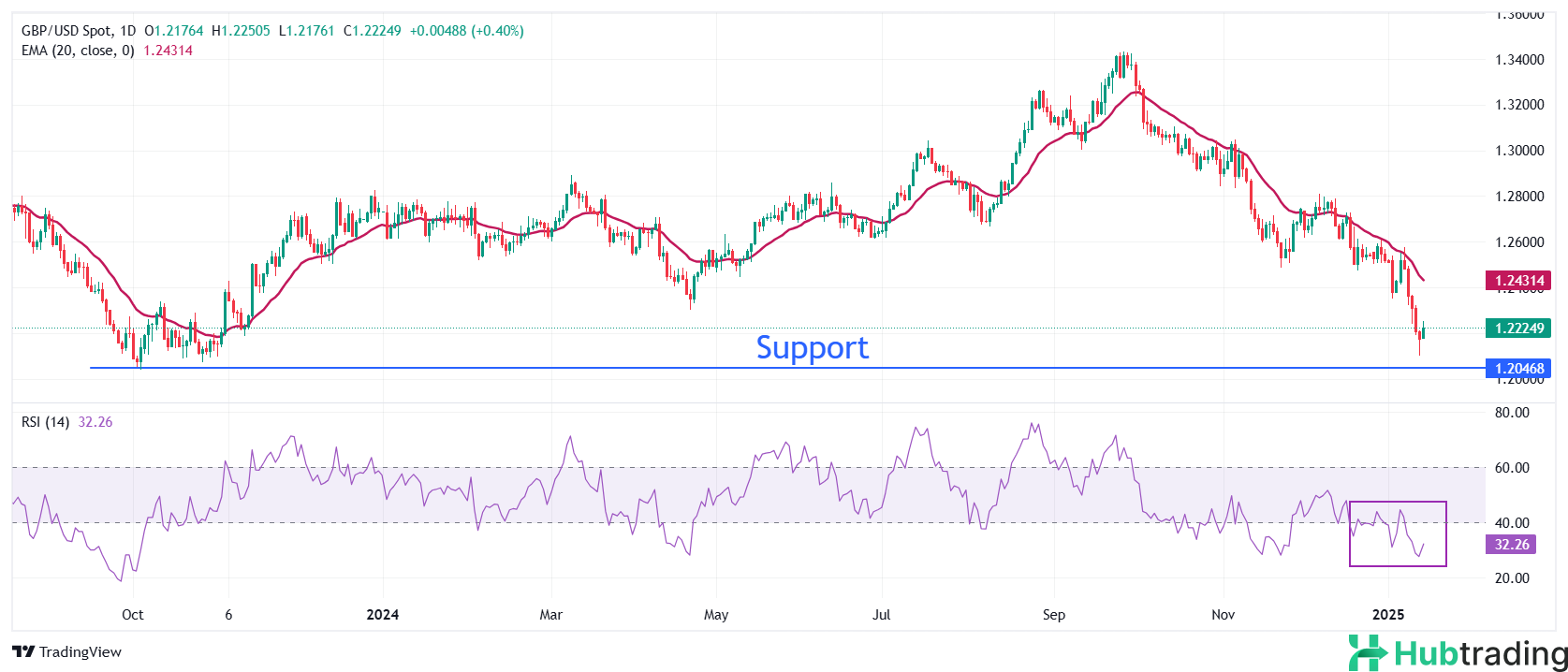- The Pound Sterling shows a modest recovery following a sharp sell-off in recent sessions, as investors turn their attention to the upcoming UK CPI data for December, due on Wednesday.
- Despite a weak overall outlook, the British currency finds some support from elevated UK gilt yields.
- Market participants also await US inflation data, which is expected to shape expectations for the Federal Reserve’s policy direction.
The Pound Sterling (GBP) finds temporary support on Tuesday after a sharp sell-off in recent sessions, driven by rising UK gilt yields. The 30-year UK gilt yield has surged to nearly 5.47%, the highest level since 1998, amid multiple headwinds including uncertainty over potential trade policies under US President-elect Donald Trump, persistent inflationary pressures, and slower growth expectations in the UK.
The sharp rise in gilt yields has created challenges for UK Chancellor of the Exchequer Rachel Reeves, who is already under pressure from employers over increased National Insurance (NI) contributions. This leaves limited fiscal flexibility should economic conditions worsen.
Market participants expect the UK government to rely more on foreign financing to manage routine spending and avoid escalating domestic borrowing costs. However, the finance ministry has reaffirmed its commitment to borrowing strictly for investment purposes, not for day-to-day expenses.
Attention now shifts to the UK Consumer Price Index (CPI) data for December, set to be released on Wednesday. This data is critical for shaping market expectations for the Bank of England’s (BoE) monetary policy decision at its February meeting.
Analysts at UBS predict the BoE will begin cutting interest rates next month, with additional reductions likely later in the year. UBS noted that elevated borrowing costs are tightening financial conditions across the economy. While inflationary pressures persist, they are diminishing, supporting the case for a rate cut in February and further easing throughout the year.
Daily Market Movers: Pound Sterling Edges Higher Against USD Ahead of US PPI
- The Pound Sterling climbs to near 1.2250 against the US Dollar (USD) in Tuesday’s European session, rebounding from Monday’s yearly low of 1.2100. Despite the recovery, GBP/USD remains under pressure amid expectations of fewer interest rate cuts by the Federal Reserve (Fed) this year. Meanwhile, the US Dollar Index (DXY), which measures the Greenback against six major currencies, dips slightly to around 109.60 after hitting a more-than-two-year high above 110.00 on Monday.
- Barclays strategists have revised their forecast for Fed interest rate cuts, now expecting only one cut this year instead of two. This adjustment reflects stronger-than-expected US labor market data and persistent inflationary pressures.
- Investors await Wednesday’s release of the US Consumer Price Index (CPI) data for December. Headline inflation is projected to rise year-on-year to 2.8% from 2.7% in November, with core inflation expected to grow steadily at 3.3%.
- Stubborn inflation data could reinforce expectations that the Fed will hold off on rate cuts this year. However, even a slowdown in inflation is unlikely to fuel dovish bets, as Trump administration policies, including immigration controls, tax cuts, and tariff hikes, are anticipated to drive economic growth.
- In Tuesday’s session, attention will turn to the US Producer Price Index (PPI) data for December, scheduled for release at 13:30 GMT.
Technical Analysis: Pound Sterling Marginally Recovers as RSI Signals Oversold Conditions

The Pound Sterling edges higher to around 1.2250 against the US Dollar during Tuesday’s European session, recovering slightly from Monday’s more-than-a-year low near 1.2100. Despite the rebound, the outlook for GBP/USD remains bearish, as the sharply declining 20-day Exponential Moving Average (EMA) near 1.2430 underscores a strong downward trend in the near term.
The 14-day Relative Strength Index (RSI) has slightly recovered after dropping below 30.00, signaling oversold conditions. However, the broader bearish bias persists unless the RSI moves back into the 20.00–40.00 range.
On the downside, support is expected near the October 2023 low of 1.2050. On the upside, the 20-day EMA will serve as a critical resistance level for the pair.





